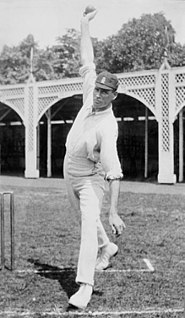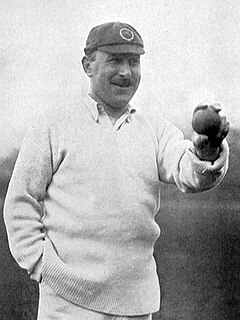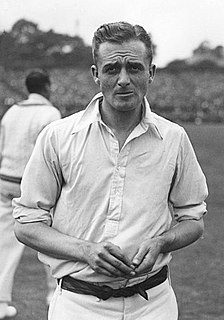
Hedley Verity was a professional cricketer who played for Yorkshire and England between 1930 and 1939. A slow left-arm orthodox bowler, he took 1,956 wickets in first-class cricket at an average of 14.90 and 144 wickets in 40 Tests at an average of 24.37. Named as one of the Wisden Cricketers of the Year in 1932, he is regarded as one of the most effective slow left-arm bowlers to have played cricket. Never someone who spun the ball sharply, he achieved success through the accuracy of his bowling. On pitches which made batting difficult, particularly ones affected by rain, he could be almost impossible to bat against.

Sydney Francis Barnes was an English professional cricketer who is regarded as one of the greatest bowlers of all time. He was right-handed and bowled at a pace that varied from medium to fast-medium with the ability to make the ball both swing and break from off or leg. In Test cricket, Barnes played for England in 27 matches from 1901 to 1914, taking 189 wickets at 16.43, one of the lowest Test bowling averages ever achieved. In 1911–12, he helped England to win the Ashes when he took 34 wickets in the series against Australia. In 1913–14, his final Test series, he took a world record 49 wickets in a test series, against South Africa.

Robert Peel was an English professional cricketer who played first-class cricket for Yorkshire between 1883 and 1897. Primarily a left-arm spin bowler, Peel was also an effective left-handed batsman who played in the middle order. Between 1884 and 1896, he was regularly selected to represent England, playing 20 Test matches in which he took 101 wickets. Over the course of his career, he scored 12,191 runs and took 1,775 wickets in first-class cricket. A match-winning bowler, particularly when conditions favoured his style, Peel generally opened the attack, an orthodox tactic for a spinner at the time, and was highly regarded by critics.

Wilfred Rhodes was an English professional cricketer who played 58 Test matches for England between 1899 and 1930. In Tests, Rhodes took 127 wickets and scored 2,325 runs, becoming the first Englishman to complete the double of 1,000 runs and 100 wickets in Test matches. He holds the world records both for the most appearances made in first-class cricket, and for the most wickets taken (4,204). He completed the double of 1,000 runs and 100 wickets in an English cricket season a record 16 times. Rhodes played for Yorkshire and England into his fifties, and in his final Test in 1930 was, at 52 years and 165 days, the oldest player who has appeared in a Test match.

Herbert Sutcliffe was an English professional cricketer who represented Yorkshire and England as an opening batsman. Apart from one match in 1945, his first-class career spanned the period between the two world wars. His first-class debut was delayed by the First World War until 1919 and his career was effectively terminated in August 1939 when he was called up for military service in the imminent Second World War. He was the first cricketer to score 16 centuries in Test match cricket.

Schofield Haigh was a Yorkshire and England cricketer. He played for eighteen seasons for Yorkshire County Cricket Club, for England from the 1898/99 tour to 1912, and was a Wisden Cricketer of the Year in 1901.

William Attewell was a cricketer who played for Nottinghamshire County Cricket Club and England. Attewell was a medium pace bowler who was renowned for his extraordinary accuracy and economy. On the many sticky or crumbling pitches encountered in his prime Attewell could get on a great deal of spin so as to always beat the bat, whilst his accuracy would make slogging – the only way to make runs under such conditions – very difficult. He was responsible for the development of "off theory" – bowling wide of the off stump to a packed off-side field to frustrate batsmen on the rapidly improving pitches of the 1890s. At times Attewell was a useful batsman for his county, and he scored 102 against Kent in 1897.

George Herbert Hirst was a professional English cricketer who played first-class cricket for Yorkshire County Cricket Club between 1891 and 1921, with a further appearance in 1929. One of the best all-rounders of his time, Hirst was a left arm medium-fast bowler and right-handed batsman. He played in 24 Test matches for England between 1897 and 1909, touring Australia twice. He completed the double of 1,000 runs and 100 wickets in an English cricket season 14 times, the second most of any cricketer after his contemporary and team-mate Wilfred Rhodes. One of the Wisden Cricketers of the Year for 1901, Hirst scored 36,356 runs and took 2,742 wickets in first-class cricket. In Tests, he made 790 runs and captured 59 wickets.

Maurice Leyland was an English international cricketer who played 41 Test matches between 1928 and 1938. In first-class cricket, he represented Yorkshire between 1920 and 1946, scoring over 1,000 runs in 17 consecutive seasons. A left-handed middle-order batsman and occasional left-arm spinner, Leyland was a Wisden Cricketer of the Year in 1929.

Willis Robert Cuttell was an English cricketer. Along with Albert Hallam, his support for Briggs and Mold gave Lancashire its first official County championship victory in 1897. His bowling was also important to Lancashire's Championship win seven years later, in which they went through the whole season without being beaten.

John Richmond Gunn was an English cricketer who played in six Test matches from 1901 to 1905.

Abraham "Abe" Waddington, sometimes known as Abram Waddington, was a professional cricketer for Yorkshire, who played in two Test matches for England, both against Australia in 1920–21. Between 1919 and 1927 Waddington made 255 appearances for Yorkshire, and in all first-class cricket played 266 matches. In these games, he took a total of 852 wickets with his left arm fast-medium bowling. Capable of making the ball swing, Waddington was admired for the aesthetic quality of his bowling action. He was a hostile bowler who sometimes sledged opposing batsmen and questioned umpires' decisions, behaviour which was unusual during his playing days.

George Gibson Macaulay was a professional English cricketer who played first-class cricket for Yorkshire County Cricket Club between 1920 and 1935. He played in eight Test matches for England from 1923 to 1933, achieving the rare feat of taking a wicket with his first ball in Test cricket. One of the five Wisden Cricketers of the Year in 1924, he took 1,838 first-class wickets at an average of 17.64 including four hat-tricks.
Dick Tyldesley was a Lancashire cricketer who was one of the most important figures in Lancashire breaking Yorkshire's stronghold on the County Championship between 1926 and 1930.
Ted Dexter captained the English cricket team in Australia in 1962–63, playing as England in the 1962-63 Ashes series against the Australians and as the MCC in their other matches on the tour. In October, the team played a match in Colombo during a stopover on the voyage to Australia. After leaving Australia in February, they played a three-match Test series in New Zealand.
Emmott Robinson was an English first-class cricketer, who played for Yorkshire County Cricket Club from 1919 to 1931. He was awarded his county cap in 1920. Robinson was a right-handed batsman who bowled right-arm fast-medium pace.
The Roses Match refers to any game of cricket played between Yorkshire County Cricket Club and Lancashire County Cricket Club. Yorkshire's emblem is the white rose, while Lancashire's is the red rose. The associations go back to the Wars of the Roses in the 15th century. These matches have a long and proud history and are traditionally the hardest fought matches in the English first class game, with many dour draws recorded as both teams battled to avoid the ignominy of defeat.
The "Six Giants of the Wisden Century" are six cricketers who were judged by Sir Neville Cardus in 1963 to have been the most notable players of the previous 100 years. Cardus made his selection at the request of Wisden Cricketers' Almanack for its 100th annual edition published that year.
The 1896 County Championship was the seventh officially organised running of the County Championship, and ran from 4 May to 31 August 1896. Yorkshire County Cricket Club claimed victory that year, winning 16 of their 26 matches and losing only three. Five of Yorkshire's players made over 1,000 runs in the season, including John Brown who was placed third nationally, while Yorkshireman Bobby Peel was sixth highest wicket taker and Schofield Haigh held one of the leading bowling averages. Although Yorkshire had a crop of players accruing these statistics, Kumar Shri Ranjitsinhji of Sussex took the plaudits for the most runs that year, 1,698, at the highest average, 58.55, while Surrey's Tom Richardson took the most wickets – 191, and William Attewell of Nottinghamshire returned the best average – 14.63 for his 87 wickets.
Walter Attewell was an English cricketer active in first-class cricket in the 1890s, making five appearances for four different teams.













